Conversations
Artist Activist
Charles Gaines with Kate Fowle on the special difficulties of environmental advocacy in the art world
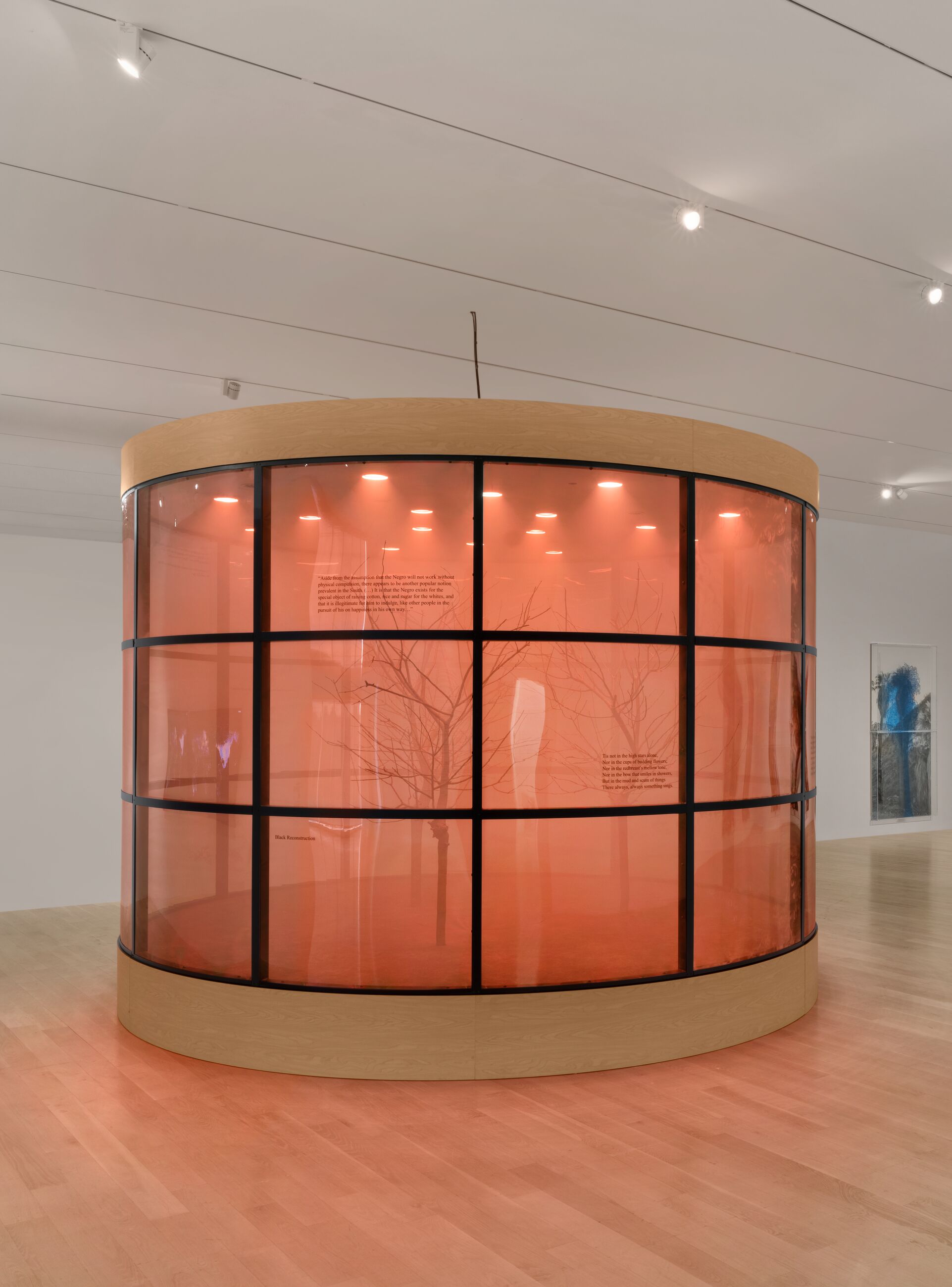
Charles Gaines, Greenhouse, 2003–23. Installation view, “Charles Gaines: 1992–2023,” Institute of Contemporary Art Miami, 2023. Photo: Photo: Zachary Balber
- 11 July 2025
- This article was originally published as part of a special sustainability section in Issue 13.
- Related Artist
- Charles Gaines
It’s perhaps fitting that the subject of Greenhouse, one of Charles Gaines’s longest-evolving works, spanning two decades, is climate change. The first iteration of the piece appeared in 2004 as a commission for a large solo show at Triple Candie in New York; the second in 2007 for LAXART in Los Angeles; and the latest was recently on view at the Phoenix Art Museum as a part of Gaines’s major survey “Charles Gaines: 1992–2023.”
Each iteration consists of a large translucent chamber, inside which an environment is formed by the processing of live data, made visible on external monitors. In New York, Gaines filled the chamber with synthetic poppies under colored lights—red, green, blue and yellow—the colors correlating with four air pollutants measured in the Los Angeles area: carbon monoxide, nitrogen dioxide, particulates and ozone. As the density of each pollutant rose and fell in real time, the luminosity of the corresponding color changed.
In Los Angeles, satellite views of the city were represented by poppies on the floor, and relative views of the night sky adorned the ceiling. In addition to lights, a fog machine was added. Both were driven by a computer that turned telemetric updates of pollutant data from the South Coast Air Quality Management District into voltage. Every fifteen minutes, readouts—such as “762: Nitrogen Dioxide”—were refreshed on the monitor, and a control unit triggered changes in the appearance of the “smog” and the light.
For the most recent version, the enclosure is cylindrical, larger (sixteen feet in diameter) and contains three stainless-steel trees as well as lights and a smoke machine. Instead of data from pollutants, the piece focuses on temperature. While one monitor emits data visualizations of recorded temperature changes around the world from the 18th century to the present, a second shows evolving current conditions, which then drive internal atmospheric changes. On the screen, global trends over time are rendered in pixels: orange for warming, green for stability and blue for cooling.
Gaines considers Greenhouse to be a continuation of what he calls his “Disaster” series, which began in 1995 with Night/Crimes and inspired his machine works Airplanecrash Clock (1997) and Falling Rock (2000) as well as, more recently, a series of graphite drawings titled Explosion. Gaines says he is interested in focusing on disasters as a way of examining how we experience art, “in particular the experience of pathos or feeling…the gap between the content and the form of its representation that produces a sense of reality.”
Following his participation in Hauser & Wirth’s Sustainability in Action conference, I sat down with Gaines to talk about his ideas for bringing art and the realities of climate change together.
—Kate Fowle

Charles Gaines, Greenhouse, 2003. Installation view, “Charles Gaines: Selected Work, 1991–2004,” Triple Candie, New York, 2004
Kate Fowle: Would you describe Greenhouse as another work in the “Disaster” series, but one that happens over time?
Charles Gaines: Yes. It’s not a typical incident, like an airplane crash, where you can see its affect. Or a rock falling on you. You feel that. These are more palpable experiences of disaster. But with Greenhouse, I was thinking about a machine that anticipates disaster. How climate change is a creeping kind of monster, created over time.
For the first iteration, I used pollutants, which are invisible. We created a computer program that would read the levels from a government website. I wanted to create an event around that, so I had a set of lights connected to each pollutant, making a link between the levels in the atmosphere and the dimness or brightness of a light. But the problem was that nothing really happened. I didn’t understand at that time the nature of the content. It would take putting a time-lapse camera in front of the Greenhouse and coming back two months later to see a difference. By the time of the LAXART show, we had a rheostat attached to the lights to control their brightness, and also to the panel that showed the pollutant numbers, which I theatricalized by using a smoke machine. I took the flowers out because the smoke would have soiled them, which I realize now was missing the point. So what if the flowers got spoiled? I mean, that's what happens, right?
“With Greenhouse, I was thinking about a machine that anticipates disaster. How climate change is a creeping kind of monster, created over time.”—Charles Gaines
KF: In the most recent version, many things have changed, but one of them is shifting from data that’s more local, such as pollutants, to temperatures.
CG: Yes, it occurred to me that I could globalize the issue this way. There are hundreds of thousands of stations keeping track of temperatures worldwide and they’re all accessed on the same site. So I could show evidence of climate change happening in the vicinity of the project, and set that up against what’s happening globally. I could also deal with the issue of time more effectively, and the fact that these behaviors are extremely durational. I could show patterns over four or five hundred years, which I couldn’t do with pollutants. Ultimately, I think the drama of the subject is more expressible if you deal with temperature.
KF: So, essentially, you have two things going on: the smoke and lights as theater and “affect” and then the passage of time, as seen through data visualization on the monitor, which is more “effect” and disaster?
CG: Charting the temperature change globally is dramatized to the extent that the orange, green and blue colored lights give it a narrative, but it’s not a fiction or an aesthetic convention. It’s just showing the mechanics of the situation. Bringing the smoke in is an aspect of aesthetic drama. Basically, I’m bringing together two things that are unrelated, which you can call a decision or judgment, but it’s not one that produces a design, because I’m not in control of the affect that the combination produces.
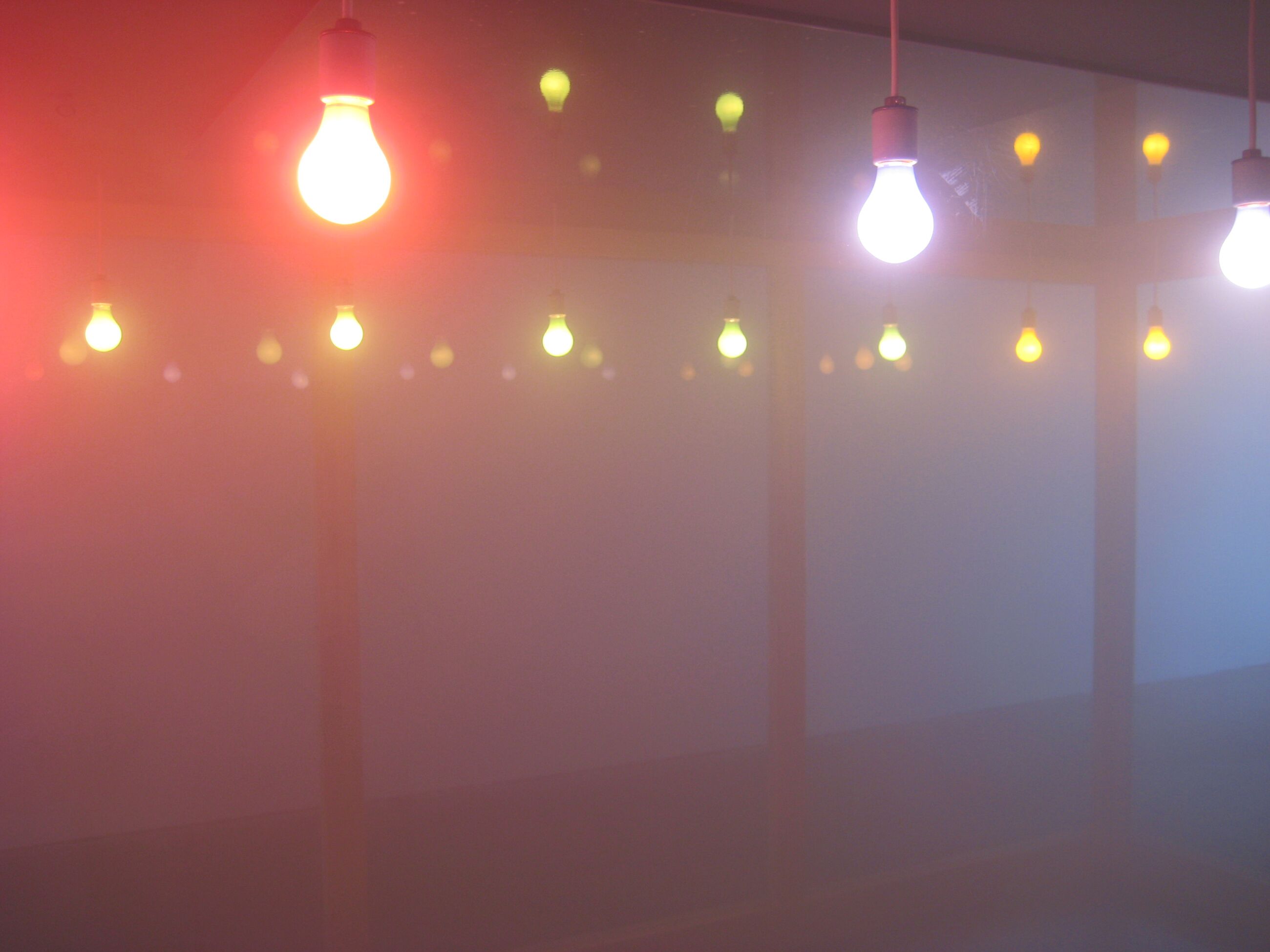
Charles Gaines, Greenhouse, 2003–2007. Installation view of “Greenhouse,” LAXART, Los Angeles, 2007
KF: Can you describe what “affect” means in this context?
CG: By affect I mean to whatever degree your feelings and emotions participate in the understanding of the experience. I was thinking a lot about Alfred Hitchcock when I was doing Night/Crimes. His mystery is built upon creating suspense, which is an affect that’s instrumentally produced.
KF: Is the proximity between the monitors and the chamber important?
CG: Bringing two or more objects that are unrelated together is a rule I’ve set up. Ultimately, it’s an assemblage. The clarification I try to make is that my interest is to reveal or critique how affect is produced, which undermines certain ideological assumptions. It’s a reconsideration of the poetic function.
When we look at a machine, the tendency is to think it’s providing a mise-en-scène, a kind of proscenium theater where the box is silent while the play unfolds. I want to un-silence the box, while what’s being played out in the narrative is unrelated. In other words—a rock crashing down, making a lot of noise, in Falling Rock is a gesture that’s unrelated to a clock. And yet I’m making a clock. The affect that’s produced by the piece is then amplified by the fact that it’s a gesture operating in time.
In terms of proximity, each Greenhouse has its measurement of real data and also a mechanical, atmospheric presence. In the Los Angeles version, seeing the carbon levels that told you whether you were in a safe or a dangerous zone was sobering because there are measures that guarantee certain death within a population. It’s chilling.
“When I put two things together, I don’t know what those two things are going to produce. I think that’s a political statement. But the work isn’t limited to it, because there’s a whole area of uncertainty I’m still involved in.”—Gaines
KF: Are you interested in the politics revealed through the work?
CG: I realized, having been told a zillion times after making Night/Crimes, that the subjects I use to play out these rules are political. I used to say “No, they're philosophical,” thinking that observation intensified representation. I was going at it the other way around. And I thought I had to hold on to that, but it turned out that I didn’t, because of the rule base I’ve created, which is the most important thing for the work to sustain itself. Ultimately, it’s a Cartesian circle. In other words: I didn’t create the piece with the intention of making a political statement, but I can’t deny the political statement being made. I mean, it’s like discovering that there’s a critical structure—or an aesthetic structure—that produces politics. Or you can look at it the other way: It’s the politics that reveal the aesthetics.
KF: So, there is a way to understand climate change as a political critique of art or culture, similarly to other political critiques, such as racism or feminism?
CG: Yes. We’ve come to the point where certain political ideas are no longer considered to be outside of art, because of the dismantling of the Eurocentric model of the universal subject. But, equally, the intention is not to limit the idea of art with the possibility that you can deal with politically charged subjects. Let me put it this way: When I put two things together, I don't know what those two things are going to produce. I think that's a political statement. But the work isn’t limited to it, because there's a whole area of uncertainty I’m still involved in.
KF: Does affect create an epiphany?
CG: For me, the epiphany is to show that affect is a political and discursive-language-based experience, and not a purely poetic one. I don’t know how it’s produced, or if it’s ever produced—because the work is rule-based, not instrumental—but I haven’t removed it as a possibility.
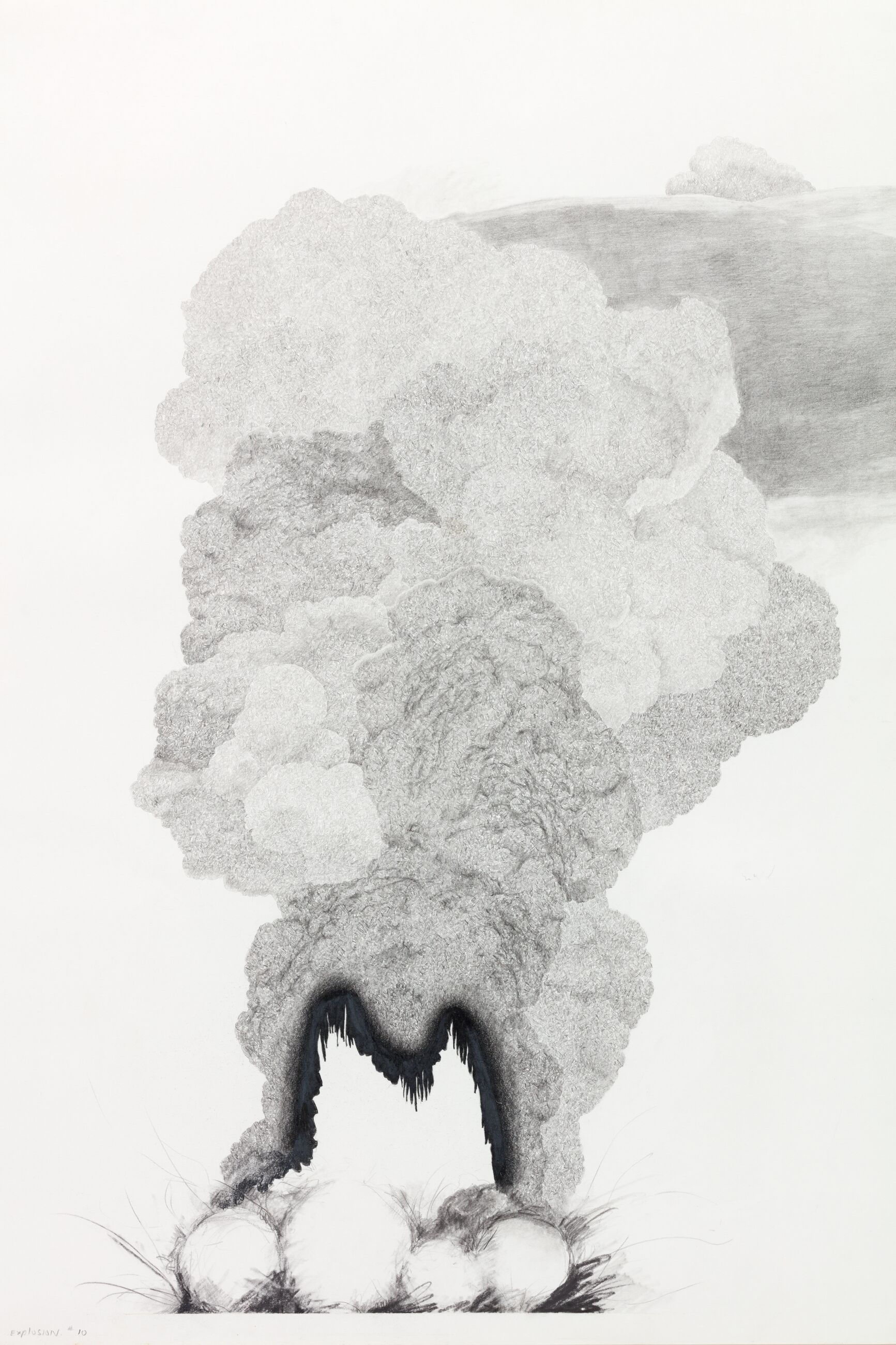
Charles Gaines, Explosion #13 (detail), 2006. Photo: Zachary Balber
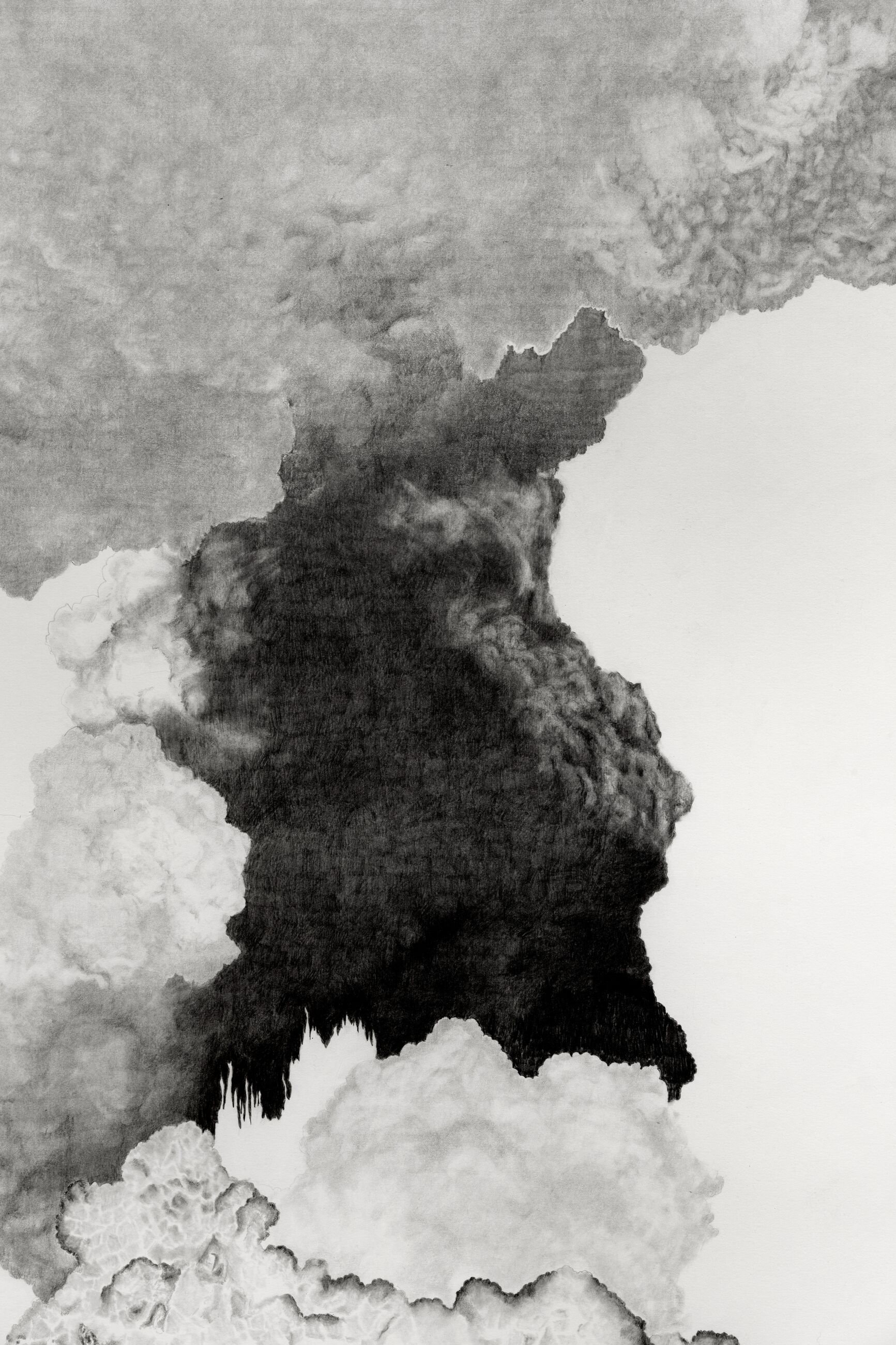
Charles Gaines, Explosion #27, 2008. Photo: Zachary Balber
Charles Gaines: Notes on Climate Change and Art
1
The general proposition: How do we consider the politics of global warming in both the art object and the practice of art?
2
One way is to compare it to other instances in which concepts or ideologies considered to be outside the domain of art have ended up revising the definition of art. A part of this change is a change in the language used to critique art. Consider the movement from modernism to postmodernism. Modernism formed a specific aesthetic language identified as art’s domain. It was generally defined as a universal language and existed in opposition to the nonuniversal or the cultural. In postmodernism, cultural constructs became part of the critical domain of art.
3
Climate change is a social construct, backed by science. It is considered in relation to economic theories, such as capitalism, and becomes a political issue in relation to that. Its transition into art depends on an idea of art that possesses cultural and political constructs within its critical language. Postmodern theory made this possible. The implication is that climate change would not, under modernism, be considered within the domain of art, but in the domain of culture, and therefore a political issue.
4
So there is a way to understand climate change as a political critique of culture that is not unlike many other political critiques of culture, such as racism, feminism, Marxism and postcolonial theory. It is a way of considering a long-standing subject in art—nature—politically. (A political read of nature.)
5
Representations of nature can also be critiques of the social and political understanding of nature. This extends both to the art object and how we interpret the experiences it produces, as well as to the practice and process of making a work of art. The politics of nature extends to artists’ understanding of the materials they work with, even if the artists are not using that material with political intent.
6
It’s one thing to think about how art can advance the progressive agenda of climate change through ideas of material construction, exhibition strategies and the implementation of market strategies that protect the environment. It’s another to take up the idea in the form of criticism or to invoke it as a critical strategy in order to unpack the politics of climate change in the formal language of art.
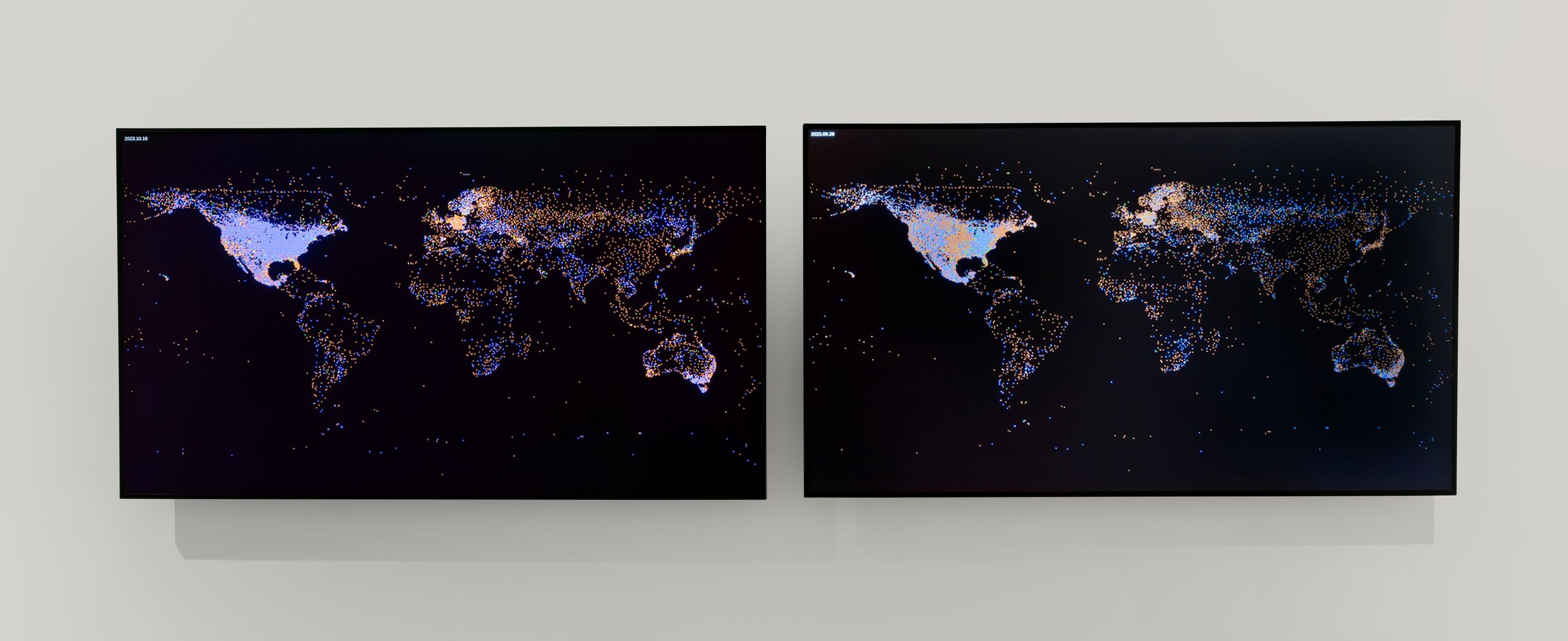
Charles Gaines, Greenhouse, 2003–23 (detail). Installation view, “Charles Gaines: 1992–2023,” Institute of Contemporary Art Miami, 2023. Photo: Zachary Balber
Charles Gaines: On Art and Activism
How do we consider the issues of sustainability in relation to art? How does art engage the politics of climate change, and the protection of the environment, beyond pragmatic decisions?
Climate change is considered a science, but in art it’s treated as a political construct, subject to critical examination and debate rather than being understood as a rule. Being a legitimate science is not a determining factor for its legitimacy in art, because it is operating under a system of criticism that is philosophical, political and moral, which is essentially the cultural domain.
In this context, we can certainly talk about the politics of climate change in individual works, and engage it by advancing a new understanding of the world through the formal language of art. And we can examine whether an individual practice is contributing to climate change. But in the domain of the idea of art, what if a practice is, in fact, contributing to climate change? What do we do about this?
The gallery and the museum can be controlled by laws put into place through legislation. But when an artist does something that is believed to contribute to global warming, or to reject the legitimacy of the idea, we cannot pass legislation to stop artmaking. The recourse is through criticism, making the argument to reject the ideological foundation upon which that art is built.
Conversely, there is also a way to understand climate change as a political critique of culture that, through criticism, can change the contours of art’s domain, in the same way that many other political critiques of culture such as racism, feminism, Marxism and postcolonial theory have done.
To noncapital cultures, like the Native American population, the idea of sustainability is a natural construct that produces a historical timeline in which one thing is privileged over another. Having dealt with sustainability as a natural process, the population discovered it as a political idea only when colonialism took place. It’s a battle for that approach to communication to have saliency in the world and in art. There’s a kind of a romantic dependency on what art can actually do, or on art as a mode of engagement. The problem is, as difficult as it is to advance ideas of sustainability in the general culture, it’s just as difficult for the art world to embrace and accept those as critical concepts inextricable from art.
Artist activists have the toughest job because they operate within two domains where a lot of resistance exists. In the art domain, further complexity is revealed in whatever idea is being addressed. It’s easier if you’re just an activist. It’s not easy to be an activist, but it’s a special difficulty to be both.
–
A pivotal figure in the field of conceptual art, Charles Gaines engages formulas and systems that interrogate relationships between objective and subjective realms. He lives and works in Los Angeles, where he was on the faculty at CalArts for over thirty years.
For more than thirty years, Kate Fowle has developed an international practice as a curator, writer and educator. She is currently the director of arts programs for the Hearthland Foundation. Prior to this, she was a senior curatorial director at Hauser & Wirth and director of MoMA PS1 in New York.
–
Ursula Issue 13 includes a special section about the environment, as considered by a diverse group of artists, writers and activists. The section takes readers to Puerto Rico, where Daniel Lind-Ramos’s work is rooted in the Caribbean mangrove ecosystem and the dangers threatening it; to Los Angeles, where Charles Gaines has long fused conceptual sculpture and information conveying the speed at which environmental damage is occurring; around the world to see the imagery of the international movement known as Solarpunk, which promotes the power of hopeful imagination in the face of increasing climate threats; and to New York’s Healthy Materials Lab, a design research lab at Parsons School of Design radically retooling the spaces in which we live and work. The section ends with a moving essay by the artist Ross Simonini, a longtime resident of Altadena, Calif., who lost his home and his neighborhood in the recent Los Angeles wildfires.
